Advertising, public relations, personal selling, and sales promotion are the elements of promotion. In this section, we discuss each in terms of goals, advantages and disadvantages, and basic forms. A good plan integrates these elements—based on the overall strategy. For example, a movie theater concentrates on ads and sales promotion (food displays), whereas an upscale specialty store stresses personal selling. See Figure 19-1.
Retailers devote significant sums to promotion. A typical department store, for instance, spends up to 4 to 5 percent of sales on ads and 8 to 10 percent on personal selling and support services. And most department store chains also invest heavily in sales promotions and use public relations to generate favorable publicity and reply to media information requests. We have several posts related to the retail promotion mix at our blog (www.bermanevansretail.com).
1. Advertising
Advertising is paid, nonpersonal communication transmitted through out-of-store mass media by an identified sponsor. Four aspects of this definition merit clarification:
- Paid form: This distinguishes advertising from publicity (an element of public relations), for which no payment is made by the retailer for the time or space used to convey a message.
- Nonpersonal presentation: A standard message is delivered to the entire audience, and it cannot be adapted to individual customers (except with the Web).
- Out-of-store mass media: These include newspapers, radio, TV, the Web, and other mass channels, rather than personal contacts. In-store communications (such as displays) are considered sales promotion.
- Identified sponsor: The sponsor’s name is clearly divulged, unlike publicity. See Figure 19-2.
Amazon has the highest annual dollar advertising expenditures among U.S. retailers—nearly $4 billion. However, this represents just 3.5 percent of U.S. sales. Amazon relies on targeted online advertising, television advertising, public relations, its Associates program (where participants get commissions when their customer referrals result in product sales), cooperative advertising with vendors, and price promotions such as percentage discounts off current purchases and inducement offers for discounts on future purchases subject to a minimum current purchase.3 Table 19-1 shows advertising ratios for several retailing categories.
DIFFERENCES BETWEEN RETAILER AND MANUFACTURER ADVERTISING STRATEGIES Retailers—other than national chains and online firms—usually have more geographically concentrated target markets than do manufacturers. This means they can adapt better to local needs, habits, and preferences. However, those retailers cannot utilize national media as readily as manufacturers. Only the largest retail chains and franchises can advertise on national TV programs. An exception is direct marketing (including the Web) because trading areas for even small firms can then be geographically dispersed.
Retail ads stress immediacy. Individual items are placed for sale and advertised over short time periods. Manufacturers are more often concerned with developing favorable attitudes.
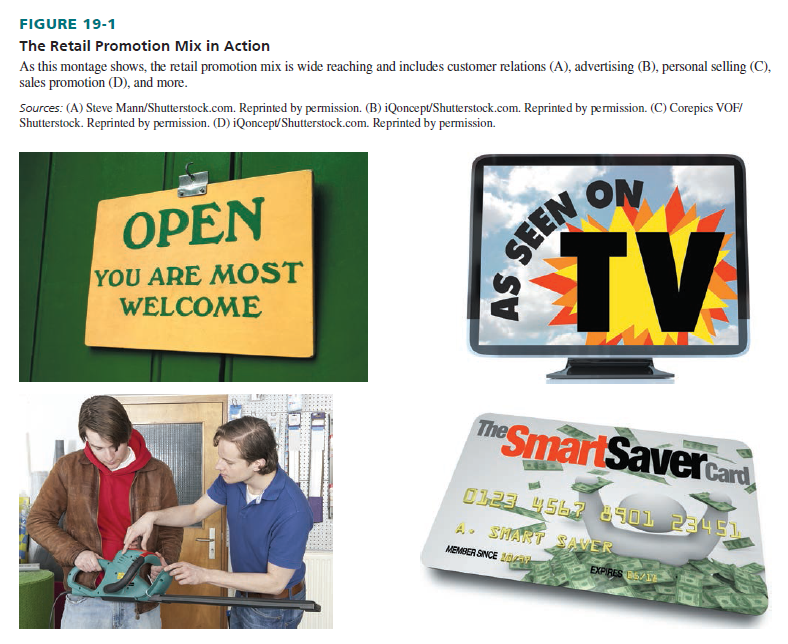
Many retailers stress prices in ads, whereas manufacturers usually emphasize key product attributes. In addition, retailers often display several different products in one ad, whereas manufacturers are likely to minimize the number of products mentioned in a single ad.
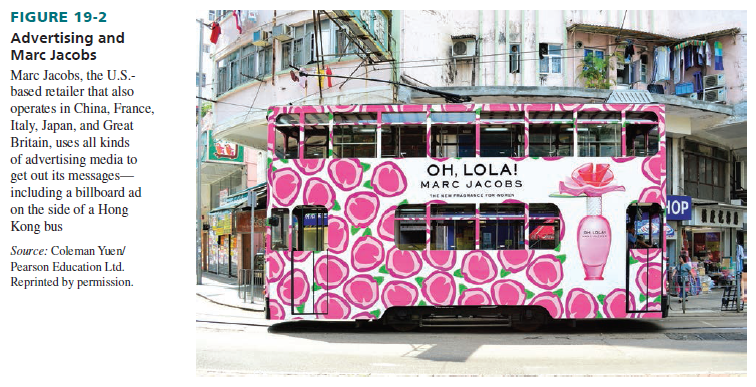
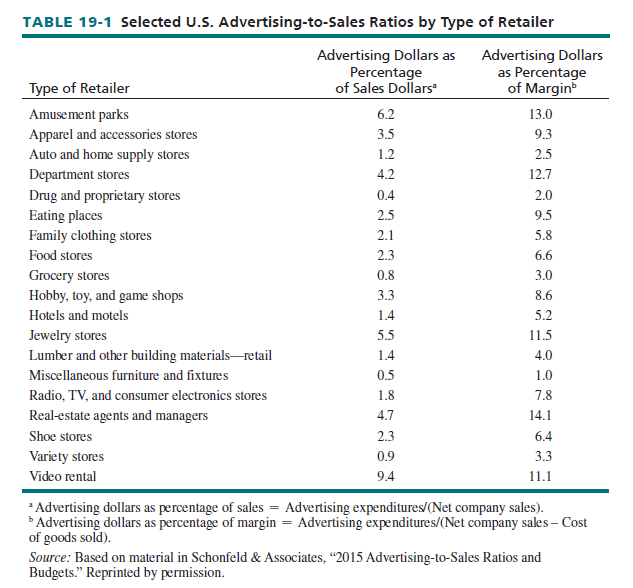
Media rates tend to be lower for retailers. Because of this, and the desire of many manufacturers and wholesalers for wide distribution, the costs of retail advertising are sometimes shared by manufacturers or wholesalers and their retailers. Two or more retailers may also share costs. Both of these approaches entail cooperative advertising.
OBJECTIVES A retailer would select one or more of these goals and base advertising efforts on it (them):
- To grow short-term sales
- To increase customer traffic
- To develop and/or reinforce a retail image
- To inform customers about goods and services and/or company attributes
- To ease the job for sales personnel
- To stimulate demand for private brands
ADVANTAGES AND DISADVANTAGES The major advantages of advertising are:
- A large audience is attracted. For print media, circulation is supplemented by the passing of a copy from one reader to another.
- The costs per viewer, reader, or listener are low.
- A number of alternative media are available (including social media), so a retailer can match a medium to the target market.
- The retailer has control over message content, graphics, timing, and size (or length), so a standardized message in a chosen format can be delivered to the entire audience.
- In print media, a message can be studied and restudied by the target market.
- Editorial content (a TV show, a news story, etc.) often surrounds an ad. This may increase its credibility or the probability it will be read.
- Self-service or reduced-service operations are possible because a customer becomes aware of a retailer and its offerings before shopping.
The major disadvantages of advertising are:
- Standardized messages lack flexibility (except for the Web and its interactive nature). They do not focus on the needs of individual customers.
- Some media require large investments. This may reduce the access of small firms.
- Media may reach large geographic areas, and for retailers, this may be wasteful. A small supermarket chain might find that only 30 percent of an audience resides in its trading area.
- Some media require a long lead time for placing ads. This reduces the ability to advertise fad items or to react to some current events themes.
- Some media have a high throwaway rate. Circulars may be discarded without being read.
- A 30-second TV commercial or small newspaper ad does not have many details.
The preceding are broad generalities. The pros and cons of specific media are covered next.
MEDIA Retailers can choose from the media highlighted in Table 19-2 and described here.
Papers (dailies, weeklies, and shoppers) represent the preferred medium for many retailers, having the advantages of proper market coverage, short lead time, reasonable costs, flexibility, longevity, graphics, and editorial association (ads near columns or articles). Disadvantages include the possible waste (circulation to a wider area than necessary), the competition among retailers, the black-and-white format, and the appeal to fewer senses than TV. To maintain a dominant position, many papers have revamped their graphics, and some run color ads. Free-distribution shopper papers (“penny savers”), with little news content and delivery to all households in a geographic area, are popular today.
TV ads, which have grown in importance due to the rise of national and regional retailers, are far behind papers in retail promotion expenditures and have a lot of competition from digital (Web) advertising. Among the advantages are the dramatic effects of messages, large market coverage, creativity, and program affiliation (for sponsors). Disadvantages include high minimum costs, audience waste, a need for brevity and repetition, and limited availability of popular times for nonsponsors. Because cable TV is more focused than conventional stations, it appeals to local retailers.
From an advertising perspective, online retailers use Web ads to stimulate awareness and E-commerce. For store retailers, the Web provides information to customers about locations, describes products carried, lets people order catalogs, and so forth. Retailers have two opportunities to reach customers: advertising on search engines and other firms’ Web sites; and communicating with customers at their own sites. Web-based advertising has been growing at a fast pace—and will continue to do so for the foreseeable future. See Figure 19-3.
In a White Pages phone directory (in print or online), retailers get free alphabetical listings along with all other phone subscribers, commercial and noncommercial. The major advantage of the White over the Yellow Pages (in print or online) is that those who know a firm’s name are not exposed to competitors. The major disadvantage, in contrast with the Yellow Pages, is the alphabetical rather than type-of-business listing. A person unfamiliar with repair services will usually look in the Yellow Pages under “Repair.” In the Yellow Pages, firms pay for listings (and display ads, if desired) in their category. Most retailers advertise in the Yellow Pages. The advantages include widespread usage by people ready to shop, and the long life (one year or more) of the Yellow Pages. The disadvantages are that retailer awareness may not be gained and there is a lengthy lead time for new ads. Note: There has been a dramatic shift to online directories and away from printed ones.
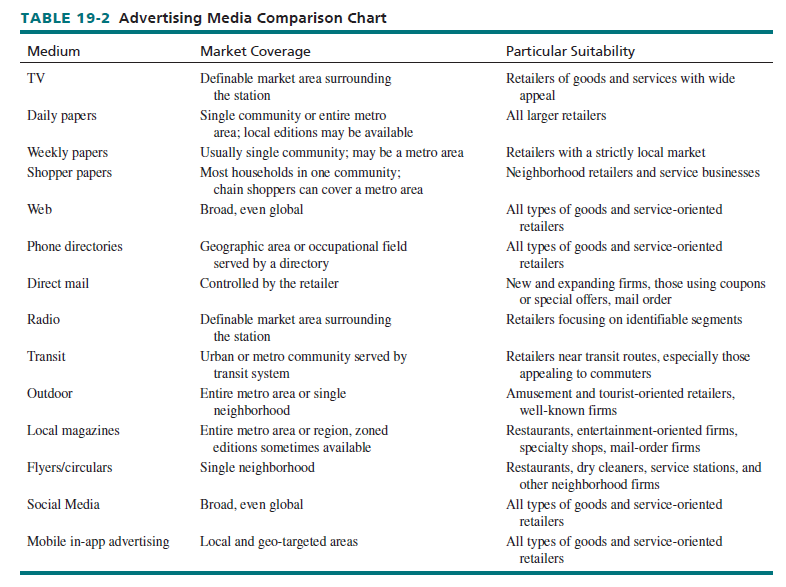
With direct mail, retailers send catalogs or ads to customers by the mail (including E-mail) or private delivery firms. Advantages are a targeted audience, tailored format, controlled costs, quick feedback, and tie-ins (including ads with bills). Among the disadvantages are the high throwaway rate (“junk mail”), poor image to some people, low response rate, and outdated mailing lists (addressees may have moved).
Radio is still used by a variety of retailers. Advantages are the relatively low costs, its value as a medium for car drivers and passengers, its ability to use segmentation, its rather short lead time, and its wide reach. Disadvantages include no visual impact, the need for repetition, the need for brevity, and waste. The use of radio by retailers has increased in recent years.
Transit advertising is used in areas with mass transit systems. Ads are displayed on buses and in trains and taxis. Advantages are the captive audience, mass market, high level of repetitiveness, and geographically defined market. Disadvantages are the ad clutter, distracted audience, lack of availability in small areas, restricted travel paths, and graffiti. Many retailers also advertise on their delivery vehicles.
Outdoor (billboard) advertising is sometimes used by retailers. Posters and signs may be displayed in public places, on buildings, and alongside highways. Advantages are the large size of the ads, the frequency of exposure, the relatively low costs, and the assistance in directing new customers. Disadvantages include the clutter of ads, a distracted audience, the limited information, and some legislation banning outdoor ads.
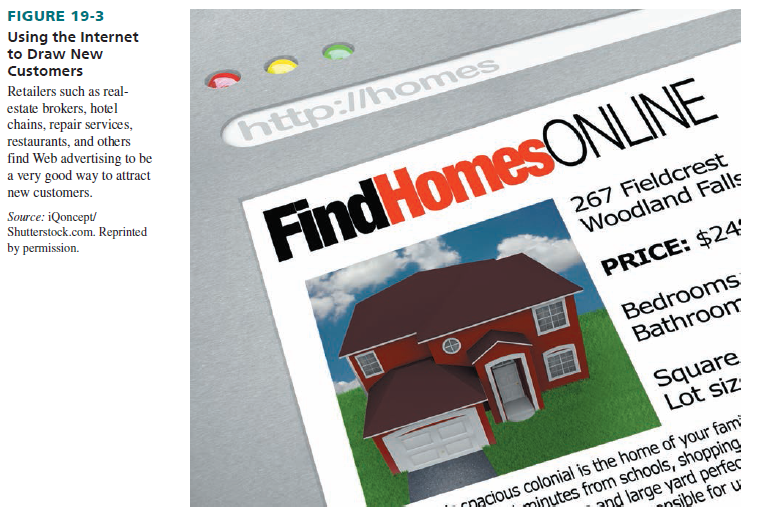
Magazine usage (in print and online) is valuable for three reasons: the number of larger retail chains, the creation of regional and local editions, and the use by nonstore and omnichannel retailers. Advantages are tailoring to specific markets, creative options, editorial associations, message longevity, and color. Disadvantages include long lead time, less sense of consumer urgency, waste, and declining readership.
Single-page (flyers) or multiple-page (circulars) ads are distributed in parking lots or to consumer homes. Advantages include the targeted audience, low costs, flexibility, and speed. Among the disadvantages are the level of throwaways, the poor image to some, and clutter. Flyers are good for smaller firms; circulars are best used by larger ones.
Social media have become the digital hub for many retailers’ Web sites. Furthermore, social media such as Facebook may provide the sole digital presence for many small retailers that do not have a Web site. Advantages include developing interactive relationships with customers; creating excitement and suggestion selling through sharing of images (Instagram, Pinterest), videos (YouTube), and information and promotions (Facebook, Twitter); and providing customer service (Yelp), identifying new customers based on their social media profiles (Facebook and Linkedin). Disadvantages include the intense competition for customer “likes,” the possibility of negative comments, and the lack of methods to measure the impact on sales.
Mobile apps are now being developed by retailers or third-party retail intermediaries (such as OpenTable), and then downloaded by customers from iPhones, Android phones, and Windows phones. Advantages include the ability to drive traffic to stores; to provide personalized, geotargeted information and time-sensitive promotions (SMS text, Snapchat); to enhance in-store experiences (Home Depot, Nordstrom); to provide out-of-store product interaction opportunities; and to complete ordering, payments, and purchases through a smartphone without the need for retail salesperson interaction. Disadvantages include technological limitations and privacy implications.
Many smartphone-only innovations such as MikMak, the first mobile shopping video network app, are redefining impulse buying. MikMak creates 30-second videos (“minimercials”) for its retail clients. The videos combine humor and music, and enable one-touch ordering and payment from the app and shipping from the sellers.4 Retailers are experimenting with E-commerce chatbots integrated into social media messenger apps such as WhatsApp, Facebook Messenger, Slack, and WeChat (China). Chatbots simulate human conversation to help customers search products, to suggest alternatives, and to offer in-app ordering and payment help to complete purchases.5
TYPES Advertisements can be classified by content and payment method. See Figure 19-4. Pioneer ads have awareness as a goal and offer information (usually on new firms, products, or locations). Competitive ads have persuasion as a goal. Reminder ads are geared to loyal customers and stress attributes that have made retailers successful. Institutional ads seek to keep retailer names before the public without emphasizing the sale of goods or services. Public service messages are institutional.
Retailers may pay their own way or seek cooperative ventures in placing ads. Firms paying their own way have total control and incur all costs. With cooperative ventures, two or more parties share costs and decision making.6 Billions of dollars are spent yearly on U.S. cooperative ads, most in vertical agreements.
In a vertical cooperative advertising agreement, a manufacturer and a retailer or a wholesaler and a retailer share an ad. Responsibilities are specified contractually, and retailers are typically not reimbursed until after the ads run. Vertical cooperative ads are subject to the Robinson-Patman Act; similar arrangements must be offered to all retailers on a proportional basis. Advantages to a retailer are reduced ad costs, assistance in preparing ads, greater market coverage, and less planning time. Disadvantages to a retailer include less control, flexibility, and distinctiveness. Some retailers are concerned about the eligibility requirements to participate and the emphasis on the supplier’s name in ads. In response, manufacturers and other suppliers are now more flexible and understanding.
With a horizontal cooperative advertising agreement, two or more retailers share an ad. A horizontal agreement is most often used by small noncompeting retailers (such as independent hardware stores), retailers in a shopping center, and franchisees of a firm. Advantages and disadvantages are similar to those in a vertical agreement. Two further benefits are the bargaining power of retailers in dealing with the media and the synergies when multiple retailers work together.
- When planning a cooperative strategy, these questions should be considered:
- What ads qualify, in terms of merchandise and special requirements? What percentage of advertising is paid by each party?
- When can ads be run? In what media?
- Are there special provisions regarding message content?
- What documentation is required for reimbursement?
- How does each party benefit?
- Do cooperative ads obscure the image of individual retailers?
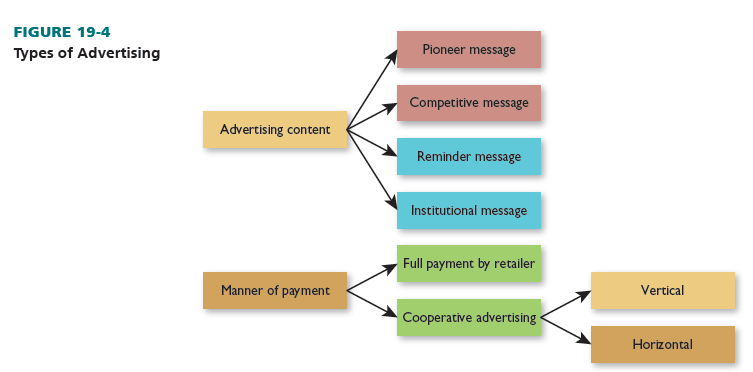
2. Public Relations
Public relations entails any communication that fosters a favorable image for the retailer among its publics (consumers, investors, government, channel members, employees, and the general public). It may be nonpersonal or personal, paid or nonpaid, and sponsor controlled or not controlled. Publicity is any nonpersonal form of public relations whereby messages are transmitted through mass media, the time or space provided by the media is not paid for, and there is no identified commercial sponsor.
The basic distinction between advertising and publicity is that publicity is nonpaid. Thus, it is not as readily controllable. A story on a store opening may not appear, appear after the fact, or not appear in the form desired. Yet, to shoppers, publicity is often more credible and valuable. Advertising and publicity (public relations) should complement one another. Therefore, on some occasions, it may be a good idea to try to gain positive publicity before placing ads.
Public relations can benefit both large and small retailers. Although the former often spend a lot of money to publicize events such as the Macy’s Thanksgiving Day Parade, small firms can creatively generate attention on a limited budget. They can feature book signings by authors, sponsor school sports teams, donate goods and services to charities, and so forth.
Social media now have a huge impact on a retailer’s public relations efforts and on the publicity it receives. Consider the influence of highly interactive blogging sites (some operated by retailers themselves), which now number as many as 300 million worldwide and rapidly spread information. Bloggers as influencers may represent real customers who reach a targeted audience and whose storytelling and opinions are trusted by their followers. They may generate active engagement, influence purchase decisions, and help drive return on investment in a way that complements other marketing activities of the retailer. The business of blogging has become more formalized and is sometimes referred to as “influencer marketing.” Blogger behavior is changing in response to the increased accountability of retailers and the availability of improved metrics, as evidenced by findings from recent blogger surveys: 7
- Blogging was often just a hobby; today, it is sometimes a career option, with successful bloggers earning a good income. More bloggers post during normal business hours than at other times or days. Although small (16 percent), some bloggers write more posts for clients than for themselves. More than half of bloggers post content on behalf of clients. Bloggers can be classified as hobbyists, professional bloggers, company bloggers who blog on behalf of firms for whom they work, and entrepreneurs who blog on behalf of their own firms.
- Several blogger influence measurement services such as Alexa.com, Blogmetrics (www .blogmetrics.org), and others document that competition among bloggers is fierce. A small percentage of viewed posts has an inordinate effect on the overall traffic and followers for top-ranked bloggers.
- Most active bloggers post at least weekly, and some write for more than one blog. Collaborating, contributing, and responding to other bloggers’ content is mutually beneficial-by sharing content and sharing followers. For example, Pottery Barn’s holiday catalog is sent to several strong influencers, who create a set of images and posts for different channels.
- Traditionally, nearly 60 percent of blog posts have been between 500 and 1,000 words. However, longer posts (more than 1,000 words) are often more effective in generating conversions; and long-form content is becoming more popular.
- The time spent writing the typical blog post is more than 2.5 hours per post, with 16 percent of bloggers spending more than 4 hours per post and 6 percent of bloggers spending more than 6 hours on a typical blog post.
OBJECTIVES Public relations seeks to accomplish one or more of these goals:
- To increase awareness of the retailer and its strategy mix To maintain or improve the company image
- To show the retailer as a contributor to the community’s quality of life
- To demonstrate innovativeness
- To resent a favorable message in a highly believable manner To minimize total promotion costs
ADVANTAGES AND DISADVANTAGES The major advantages of public relations are:
- An image can be presented or enhanced.
- A more credible source presents the message (such as a good restaurant review).
- There are no costs for message time or space.
- A mass audience is addressed.
- Carryover effects are possible (if a retailer is perceived as community-oriented, its value positioning is more apt to be perceived favorably).
- People pay more attention to independent (third-party) sources than to clearly identified ads.
The major disadvantages of public relations are:
- Some retailers do not believe in spending any funds on image-related communication.
- There is little retailer control over a publicity message and its timing, placement, and coverage by a given medium (particularly with social media).
- It may be more suitable for short-run, rather than long-run, planning.
- Although there are no media costs for publicity, there are costs for a public relations staff, planning activities, and the activities themselves (such as store openings).
- The Web can quickly turn a negative local story into a worldwide media blitz.
TYPES Public relations can be planned or unexpected and image enhancing or image detracting. With planned public relations, a retailer outlines its activities in advance, strives to have media report on them, and anticipates certain coverage. Community services, such as donations and special sales; parades on holidays (such as the Macy’s Thanksgiving Day Parade); the introduction of “hot” new goods and services; and a new store opening are activities a retailer hopes will gain media coverage. The release of quarterly sales figures and publication of the annual report are events a retailer knows will be covered.
When unexpected publicity occurs, media report on a company without giving it advance notice. TV, newspaper, magazine, Web, and other reporters may anonymously visit retail stores and Web sites or call customer service representatives to rate their performance and quality. A fire, an employee strike, or other newsworthy event may be mentioned in a story. Investigative reports on company practices—such as using suppliers with under-age workers—may appear.
There is positive publicity when media reports are complimentary, with regard to the excellence of a retailer’s practices, its community efforts, and so on. However, the media may also provide negative publicity. A story could describe a store opening in less than glowing terms, rap a firm’s environmental record, or otherwise be critical. That is why public relations must be viewed as a component of the promotion mix, not as the whole mix.
3. Personal Selling
Personal selling involves oral communication with one or more prospective customers for the purpose of making a sale. Retail salespeople include anyone who interacts face-to-face (or via the phone) with the shopper in a way that encourages that shopper to make a purchase. The level of personal selling used by a retailer depends on the image it wants to convey, the products sold, the amount of self-service, and the interest in long-term customer relationships—as well as customer expectations. Retail salespeople may work in a store, visit consumer homes or places of work; engage in telemarketing; or engage in real-time online chat.
Customer-service-oriented retailers believe in training superior sales associates. Why? First, higher levels of selling are needed to reinforce the retailer’s image as customer-centric. Unlike self-service discounters, full-service retailers want their sales staff to frequently interact with and advise customers. Second, many retailers want to stimulate cross-selling, whereby associates recommend related items to customers. Third, sales associates may be able to “save the sale” by suggesting that customers who return merchandise try different colors, styles, or quality. And last, salespeople can help foster customer loyalty. Figure 19-5 highlights sales associate tips.
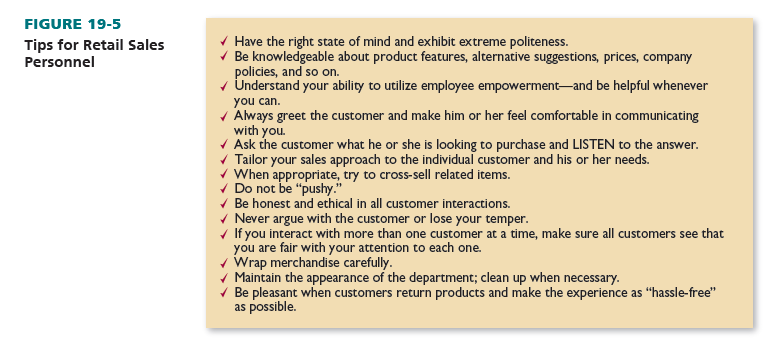
OBJECTIVES The goals of personal selling are:
- To persuade customers to buy (since they often enter a store after seeing an ad)
- To stimulate sales of impulse items or products related to customers’ basic purchases
- To complete customer transactions
- To feed information back to company decision makers
- To provide proper levels of customer service
- To improve and maintain customer satisfaction
- To create awareness of items also marketed through the Web, mail, and telemarketing
ADVANTAGES AND DISADVANTAGES The advantages of selling relate to its personal nature:
- A salesperson can adapt a message to the needs of the individual customer.
- A salesperson can be flexible in offering ways to address customer needs.
- The time commitment of the customer is higher than with advertising.
- There is less audience waste than with advertising; most people who walk into a store are potential customers.
- Customers respond more often to personal selling than to ads.
- Immediate feedback is provided.
The major disadvantages of personal selling are that:
- Only a limited number of customers can be handled at a given time.
- The costs of interacting with each customer can be high.
- Customers are not initially lured into a store or onto a Web site through personal selling.
- Self-service may be discouraged.
- Some customers may view salespeople as unhelpful and as too aggressive.
TYPES Most sales positions involve either order taking or order getting. An order-taking salesperson performs routine clerical and sales functions—setting up displays, stocking shelves, answering simple questions, and ringing up sales. This type of selling is most likely in stores that are strong in self-service but also have some personnel on the floor. An order-getting salesperson is actively involved with informing and persuading customers and in closing sales. This is a true “sales” employee. Order getters usually sell higher-priced or complex items, such as real-estate, autos, and consumer electronics. They are more skilled and better paid than order takers. See Figure 19-6.
A manufacturer may sometimes help fund personal selling by providing PMs (promotional or push monies) for retail salespeople selling its brand. This is in addition to regular salesperson compensation. Many retailers dislike this practice because their salespeople may be less responsive to actual customer desires (if customers desire brands that do not yield PMs for the salespeople).
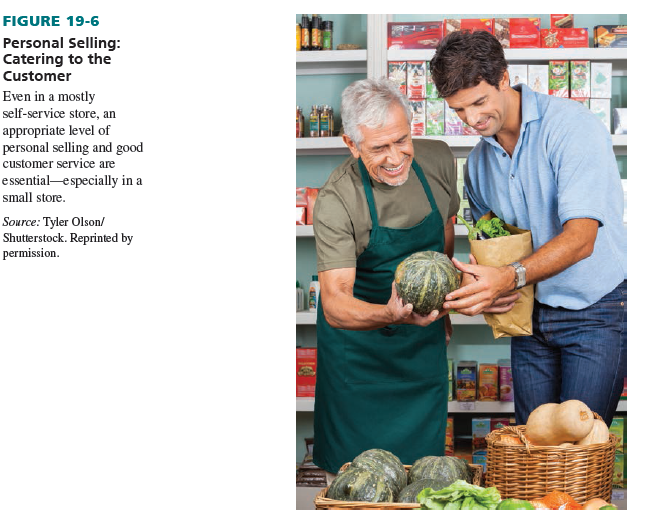
FUNCTIONS Store sales personnel may be responsible for all or many of the tasks shown in Figure 19-7 and described next. Nonstore sales personnel may also have to generate customer leads (by knocking on doors in residential areas or calling people who are listed in a local phone directory).
On entering a store or a department in it (or being contacted at home), a salesperson greets the customer. Typical in-store greetings are: “Hello, may I help you?” “Hi, is there anything in particular you are looking for?” With any greeting, the salesperson seeks to put the customer at ease and build rapport.
The salesperson next finds out what the person wants: Is the person just looking, or is there a specific good or service in mind? For what purpose is the item to be used? Is there a price range in mind? What other information can the shopper provide to help the salesperson?
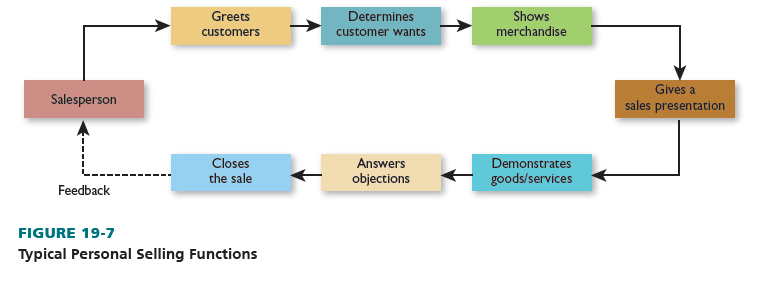
At this point, the salesperson may show merchandise. He or she selects the product most apt to satisfy the customer. The salesperson may try to trade up (discuss a more expensive version) or offer a substitute (if the retailer does not carry or is out of the requested item).
The salesperson now makes a sales presentation to motivate the customer to purchase. The canned sales presentation is a memorized, repetitive speech given to all customers interested in a particular item. It works best if shoppers require little assistance and sales force turnover is high. The need-satisfaction approach is based on the principle that each customer has different wants; thus, a sales presentation should be geared to the demands of the individual customer. It is being used more in retailing.
A demonstration can show the utility of an item and allow customer participation. Demonstrations are often used with sound systems, autos, health clubs, and watches.
A customer may have questions, and the salesperson must address them. After all questions are answered, the salesperson tries to close the sale and get the shopper to buy. Typical closing lines are: “Will you take it with you or have it delivered?” “Cash or charge?” “Would you like this gift wrapped?”
For personal selling to work well, salespeople must be enthusiastic, knowledgeable, interested in customers, and good communicators. Figure 19-8 cites several ways that retail sales can be lost through poor personal selling and how to avoid these problems.8
4. Sales Promotion
Sales promotion encompasses the paid communication activities other than advertising, public relations, and personal selling that stimulate consumer purchases and dealer effectiveness. The purpose of a promotional campaign is to build sales in the short term—or sometimes as a longterm strategy of constant promotional pushes to reach sales goals. It includes displays, contests, sweepstakes, coupons, frequent shopper programs, prizes, samples, demonstrations, referral gifts, and other limited-time selling efforts outside of the ordinary promotion routine.
The main priority of a sales promotional strategy should be to maximize profit by selling as many units as possible at full price within the “prime season,” and then to sell the remaining units at lower price. A retail promotion calendar is often based on sales history and a projection of the assortment plan for the current period. Then, the retailer plans to use various promotional tools to drive greater revenues by creating excitement, urgency, or price satisfaction at various times during the selling period. At the start of a season, full-margin sales can be driven by “prime” promotions—displays, upsells, and campaigns designed to promote and sell the intrinsic value and unique selling attributes of merchandise. As the season progresses, actual performance is tracked, with both better and worse results than planned taken into account. More promotions may then be used—such as loss leaders, markdowns, and deals (buy pants to get a polo T-shirt free) to stimulate sales while holding margins.9
The SmartSource portfolio owned by News America Marketing provides retailers and brand managers with the ability to reach their consumers through home-delivered, in-store, sampling, as well as via digital and mobile media. In-store media placed in more than 61,000 food, drug, mass, and office supply stores, reach up to 75 million households monthly. SmartSource provides information, coupons, recipes, rebates, and sweepstakes forms in the store. It also supplies samples that generate trial use for nonbrand or noncategory customers, or that influence “switchers” to buy the advertised brand over others of which they are aware., or that remind loyal users to buy the product. Mobile solutions include the SmartSource Direct2Card that is integrated into a retailer mobile app so consumers can download offers to their loyalty cards and then present the cards at checkout to have the savings automatically applied.
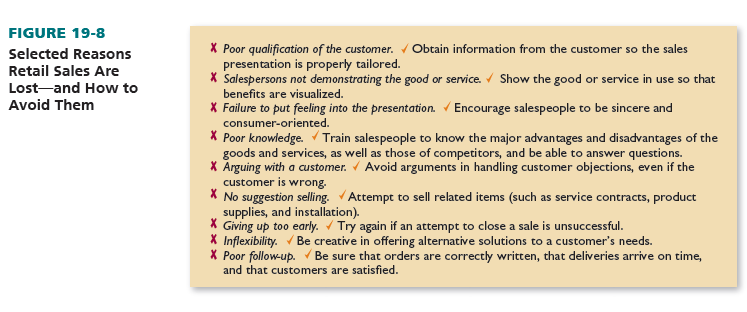
OBJECTIVES Sales promotion goals are:
- To increase short-term sales volume
- To maintain customer loyalty
- To emphasize novelty
- To complement other promotion tools
ADVANTAGES AND DISADVANTAGES The major advantages of sales promotion are that:
- It often has eye-catching appeal.
- Themes and tools can be distinctive.
- The consumer may receive something of value, such as coupons or free merchandise.
- It helps draw customer traffic and maintain loyalty to the retailer.
- Impulse purchases are increased.
- Customers can have fun, particularly with promotion tools such as contests and demonstrations. The major disadvantages of sales promotion are that:
- It may be hard to terminate certain promotions without adverse customer reactions.
- The retailer’s image may be hurt if trite promotions are used.
- Frivolous selling points may be stressed rather than the retailer’s product assortment, prices, customer services, and other factors.
- Many sales promotions have only short-term effects.
- It should be used mostly as a supplement to other promotional forms.
TYPES Figure 19-9 describes the major types of sales promotions. Each is explained here. Point- of-purchase promotion consists of in-store displays designed to lift sales. Displays may remind customers, stimulate impulse behavior, facilitate self-service, and reduce retailer costs if manufacturers provide the displays. See Figure 19-10. These data show the extent of displays:
- We estimate that U.S. manufacturers and retailers together annually spend more than $20 billion on in-store displays, with retailers using about two-thirds of all displays provided by manufacturers.
- Virtually all retailers have some type of point-of-purchase display.
- Restaurants, apparel stores, music/video stores, toy stores, and sporting goods stores are among the retail categories with above-average use of in-store displays.
- Display ads appear on shopping carts in most U.S. supermarkets. And thousands of supermarkets have electronic signs above their aisles promoting well-known brands.

Contests and sweepstakes are similar; they seek to attract customers who participate in events with large prizes. A contest requires a customer to show some skill. A sweepstakes only requires participation, with the winner chosen at random. Disadvantages of contests and sweepstakes are their costs, customer reliance on these tools for continued patronage, the customer effort, and entries by nonshoppers. Together, we project that U.S. manufacturers and retailers spend $2 billion yearly on contests and sweepstakes.
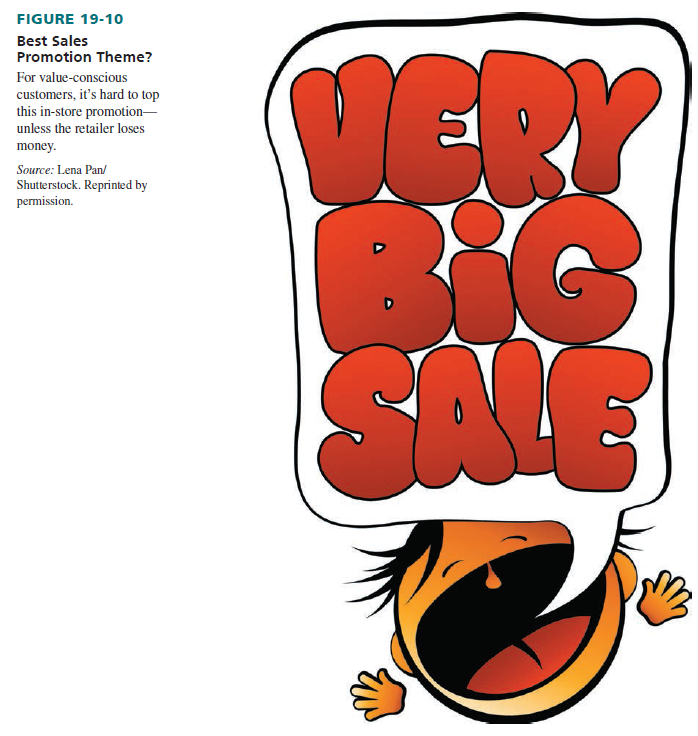
Each year, hundreds of billions of dollars in coupons—discounts from regular selling prices— are distributed in the United States, with grocery products accounting for two-thirds of them. Consumers redeem $4 billion in coupons annually; retailers receive several hundred million dollars for processing coupon redemptions. Coupons are offered through freestanding inserts in Sunday papers and placements in daily papers, direct mail, Web sites, smart phones, regular magazines, and Sunday newspaper magazines. They are also put in or on packages and dispensed from store machines.11
Coupons have four key advantages: (1) In many cases, manufacturers pay to advertise and redeem them. (2) According to surveys, about 85 percent of consumers redeem coupons at least once during the year. (3) They contribute to the consumer’s perception that a retailer offers good value. (4) Effectiveness can be measured by counting redeemed coupons. Disadvantages include the possible negative effect on the retailer’s image, consumers shopping only if coupons are available, the low redemption rates, coupon clutter, retailer and consumer fraud, and handling costs. Due to the large number of coupons distributed, less than 3 percent of them are redeemed by consumers.
Frequent shopper programs foster customer relationships by awarding discounts or prizes for continued patronage. In most programs, customers accumulate points (or the equivalent) that are redeemed for cash, discounts, or prizes. Programs following these principles are most apt to succeed in the following ways:
- Customer data are regularly collected. This enables the retailer to personalize rewards based on customer preferences and past purchases. When there are many “lapsed customers” in the database, it may be a good tactic to offer an instant reward to encourage these former shoppers to return. According to one survey, discounts on merchandise are the most important motivator.12
- A loyalty program’s format, rewards, and manner of communications have to be crafted to be relevant to the specific customer group. Loyalty programs offered through mobile apps can be personalized based on the individual shopper’s purchase history and browsing behavior.
- A membership card in a shopper’s wallet can be a constant reminder of the benefits of the loyalty program of a given retailer.
- A good loyalty program builds excitement by letting customers know exactly what rewards they can expect, how to earn them, and how they are progressing to a reward goal.
- For a loyalty program to reach a high level of customer participation, rewards should be readily obtainable and incremental to transform more customers from low value to high value.
- When intangible and exclusive services and experiences are provided at higher levels of rewards, customers will brag about reaching special membership status. This will propel even more repeat business and may politely nudge those who are in a lower reward category.
- A loyalty program can be used as part of regular digital communications with customers. Retailers can send follow-up messages after each purchase and communicate frequently to introduce new perks and special offers.13
The advantages of frequent shopper programs for retailers are the loyalty (customers amass points only by shopping at a specific firm or firms), the increased shopping, and the competitive edge for a retailer similar to others. However, some consumers feel these programs are not really free and would rather shop at lower-priced stores without loyalty programs. These shoppers believe it will take too long to gather enough points to earn meaningful gifts, and retail profit margins may be smaller if firms with these programs try to price competitively with those without the programs.
Prizes are similar to frequent shopper programs, but they are given with each purchase. They are most effective when sets of glasses, silverware, dishes, place mats, and so on are distributed one at a time to shoppers. These encourage loyalty. Problems are the cost of prizes, the difficulty of termination, and the possible impact on image.
Free samples (food tastings) and demonstrations (cooking lessons) can complement personal selling. We estimate that more than $2.5 billion is spent annually on sampling and demonstrations by U.S. stores—mostly at supermarkets, membership clubs, specialty stores, and department stores. They are effective because customers become involved and impulse purchases increase. Loitering and costs may be problems.
Referral gifts may encourage existing customers to bring in new ones. Direct marketers, such as book and music clubs, often use this tool. It is a technique that has no important shortcomings and recognizes the value of friends in influencing purchases.
Matchbooks, pens, calendars, and shopping bags may be given to customers. They differ from prizes because they promote retailers’ names. These items should be used as supplements. The advantage is longevity. There is no real disadvantage.
Retailers may use special events to generate consumer enthusiasm. Events can range from store grand openings to fashion shows. When new McDonald’s stores open, there are typically giveaways and children’s activities, and there is a guest appearance by Ronald McDonald (a human in a costume). Generally, in choosing a special event, the potential increase in consumer awareness and store traffic needs to be weighed against that event’s costs. See Figure 19-11.
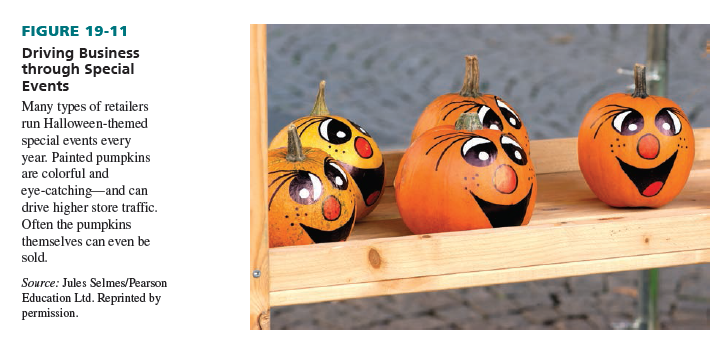
Source: Barry Berman, Joel R Evans, Patrali Chatterjee (2017), Retail Management: A Strategic Approach, Pearson; 13th edition.

Well I sincerely enjoyed reading it. This article offered by you is very constructive for correct planning.